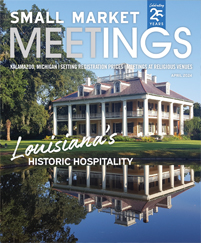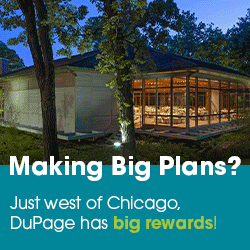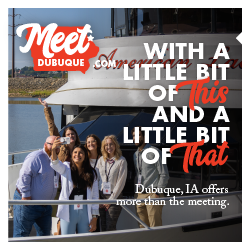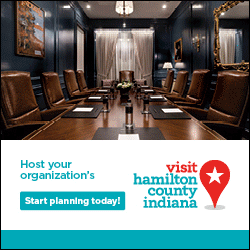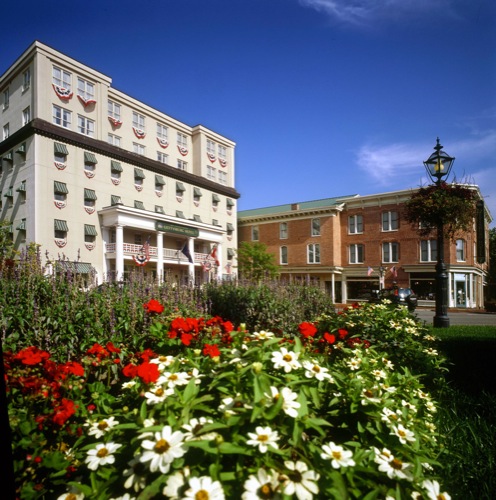
Although Gettysburg has existed for more than two centuries in south central Pennsylvania, several miles north of the Mason-Dixon line, three days put it on the map.
On July 1, 1863, a shot was fired just outside the small town. So began a decisive battle of the Civil War. By the end of the day, Southern soldiers had overrun the Northern town. For three days, the Confederate flag flew above the square as battles raged at Little Round Top, Devil’s Den, the Peach Orchard and other places a few miles away.
On July 4, after unspeakable casualties on both sides, Gen. Robert E. Lee began his retreat to Virginia, and townsfolk started cleaning up. Their homes and churches became hospitals; the town was blanketed by the sickening stench of 3,000 dead horses being burned in piles.
Tavern anchors the town
Through it all, a tavern established in 1797 anchored the northeast corner of the town square. Today the much-expanded, far more gracious Gettysburg Hotel marks that spot.
The hotel’s past is intriguing. Its ballroom was once the town’s first bank. Thaddeus Stevens had his first law office there. And the hotel was President Dwight D. Eisenhower’s temporary White House in 1955 as he recuperated from a heart attack.
Then came hard times. The hotel closed in 1964, victim to the motoring public’s preference for motels on the outskirts of towns. In 1983, destroyed by a fire, it became an embarrassing eyesore in this town, visited by 3 million tourists each year.
Historic hotel reopens
The hotel reopened in 1991, rising from its ashes after Gettysburg College and a developer invested $6 million to rebuild it.
Today, it’s a 119-room historic hotel with 7,900 square feet of flexible meeting space in the center of a charming, walkable town.
Owned by the college, the Best Western Plus hotel is one of 235 members of Historic Hotels of America. The six-story structure is the tallest in town.
In 2001, the hotel brought an adjacent building into its fold, the 1814 Bank of Gettysburg.
The bank is a ballroom
The bank is now a long ballroom with a 27-foot-high hand-painted ceiling. Although the room can’t be divided, it is suited for double settings.
“We can set up for a meeting at one end and for a meal at the other,” said Stephanie Haberkorn, the hotel’s catering sales professional.
A more intimate setting is the bank’s imposing vault, where eight people can dine under the watchful eye of a guard.
Although the ballroom accommodates 200, the best size for a meeting at the Gettysburg Hotel is probably 75, said Jennifer Millheim, the senior sales professional.
The nearby Thaddeus Stevens Room is used for breakout sessions or meetings of 60 to 80 people. An atrium connecting the ballroom to the hotel lobby serves as prefunction space.
Meeting rooms whisper history
On the other side of the lobby, two meeting rooms bear the names of respected guests. A photograph of Eisenhower speaking to a crowd in Gettysburg Square hangs in a 1,200-square-foot meeting room named for him. In the photo, spectators line the roof of the hotel, a sight not likely to be seen at a presidential address there ever again.
The 700-square-foot Daniel Webster Room commemorates the “Great Orator’s” 1833 visit. Webster spent the night, then made a speech from the hotel’s front steps.
Stevens, Eisenhower and Webster are but three of the famous — and infamous — people who have stayed at the hotel through the years. Frederick Douglass, Francis Scott Key, Henry Ford, Carl Sandburg, Richard Nixon and George Wallace are among the others.
The year ahead
The hotel is gearing up to serve as the official headquarters for the 150th anniversary of the Battle of Gettysburg in 2013.
“We will be making a $2 [million] to $4 million investment in the hotel this year,” said general manager Phillip Murray, including some as-yet-unannounced changes to bring its history alive.
Murray said the hotel will modernize its guest rooms and suites, strengthen visual ties to the college and “make the front of the hotel more friendly for our business clients.”
An avid history buff and collector of Gettysburg artifacts, Murray is proud that 50 members of his staff have been trained and certified as historic tourism ambassadors by Journey Through Hallowed Ground, a nonprofit, four-state partnership dedicated to raising awareness of American heritage.
Wining and dining
The hotel has two restaurants. Its dark-wood English pub, McClellan’s Tavern, has a bar to gather around. Centuries on the Square, the dining room, overlooks the square. Open for breakfast and dinner, Centuries is available for private events at other times.
Tourist town that it is, Gettysburg has many shops and dining options, most within walking distance.
Theaters and trains
The Gettysburg Hotel also encompasses the 816-seat Majestic Theater, built in 1925 as part of an annex.
Art house movies are shown every night; live shows are held a couple of nights each month. The lobby and balcony are available for events for up to 150 people.
When the annex was built, it included a gymnasium/auditorium. During his recuperation in 1955, President Eisenhower held press conferences there.
Ninety-two years before Ike, another president passed by. Invited to make a few remarks following the main speaker at the dedication of Soldiers’ National Cemetery on the battlefield, Abraham Lincoln arrived at Gettysburg’s train station and walked past the hotel to the home of his host, David Wills. There he fine-tuned his three-minute address; the rest is history.
The railroad station, restored last year, is available for hotel-catered events for up to 75 people.
Hallowed ground
The town surrounding the Gettysburg Hotel is a draw in itself. Historic tours leave three times a day, April through November, from the hotel atrium. But a visit to Gettysburg isn’t complete without a stop at the Gettysburg National Military Park, two miles away.
The park’s three-year-old visitor center offers a 20-minute film and a 12-gallery museum. Paul Philippoteaux’s carefully restored Cyclorama painting, longer than a football field and as tall as a four-story structure, depicts the fury of Pickett’s Charge.
The visitor center also has a 1,887-seat theater and meeting rooms. After hours, catered events for up to 300 people can be held there.
The Gettysburg Hotel has steeped in history for more than two centuries. Like the town, the hotel is defined by it.





